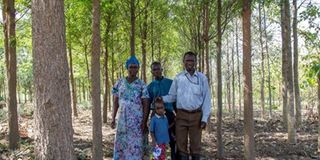Drought not drying up hopes for planting more trees in Arua

Dralea grows trees with his family; he is supported by his wife (left) and brother (centre). Photo by Henry Lubulwa
What you need to know:
West Nile successful tree farmer established a successful tree farm with training and seedlings provided by the UN refugee agency, UNHCR.
Peter Dralea walks through rows of towering trees on his West Nile farm. Although rainfall has been sporadic, he finds hope in his years of hard work and expects his freshly planted seedlings to grow tall as well.
“I’m very strongly hopeful because this is not where it started,” he said. “Where you see right now, it is many years of strongly achieving the dream.”
Dralea’s farm is located just over an hour from Arua Town in the Odobu-III village of Rhino Camp Settlement where over 20,000 refugees, mostly from South Sudan, live.
Dralea, a Ugandan national, moved to the area in 1987 and long dreamed of adding forestry to farming practices of agriculture and animal raising. Without the specialised skills and capital, starting a tree farm was a challenge.
“I was struggling on my own in order to look for seedlings, but I wouldn’t manage it,” he said.
That all changed for Dralea in 2007, he said. The United Nations refugee agency UNHCR and its partner organisations provided him support in the form of seedlings and skills training as part of a development program for the region.
“The humanitarian assistance provided to refugees is designed as such to ensure that 30 per cent of the efforts go towards benefiting the local host community,” explained Charles Yaxley, spokesperson for UNHCR, in an e-mail.
“This means that local Ugandans are not only hosting refugees from a sense of moral duty but also get something back in terms of development too.”
Dralea started tree planting on a two-acre plot in 2009 and has since expanded it by an additional two acres. He grows teak, neem and gmelina trees for timber and poles. Grafted mangoes, paw paws and jackfruit trees on his farm are harvested for food.
“Most of the trees, about 90 per cent, survived,” he adds. “I’ve harvested heavily (for) three years which is good income for me.”
The success of the tree farm has meant Dralea is earning enough to support his family, including his brothers that work with him on the farm, and pay for his children’s school fees.
This year’s drought, however, has created challenges, particularly for growing new trees.
To mitigate the effects of the drought, Dralea has begun a number of water conservation projects around his farm.
He added a gutter to one side of the roof of his house to pool rainwater that is then collected in large plastic drums. That rainwater can then be used in a simple irrigation system, built from wood and old water bottles, which drip water continuously onto individual saplings.
Dralea also hopes to eventually dig a pool for collecting water or purchasing a crest tank once he can afford it.
Familiar with the harsh climate, Dralea said he continues to grow vegetables, maize and ground nuts to ensure he has many options for food and income in the event one of the crops fail.
And he is continuously coming up with new ideas to diversify his farm.
“I was dreaming of (a) system where I’m able to keep animals on the same farm, I’m able to raise agricultural crops on the same farm, I’m able to also grow forest, plant the trees at the same time,” he said.




